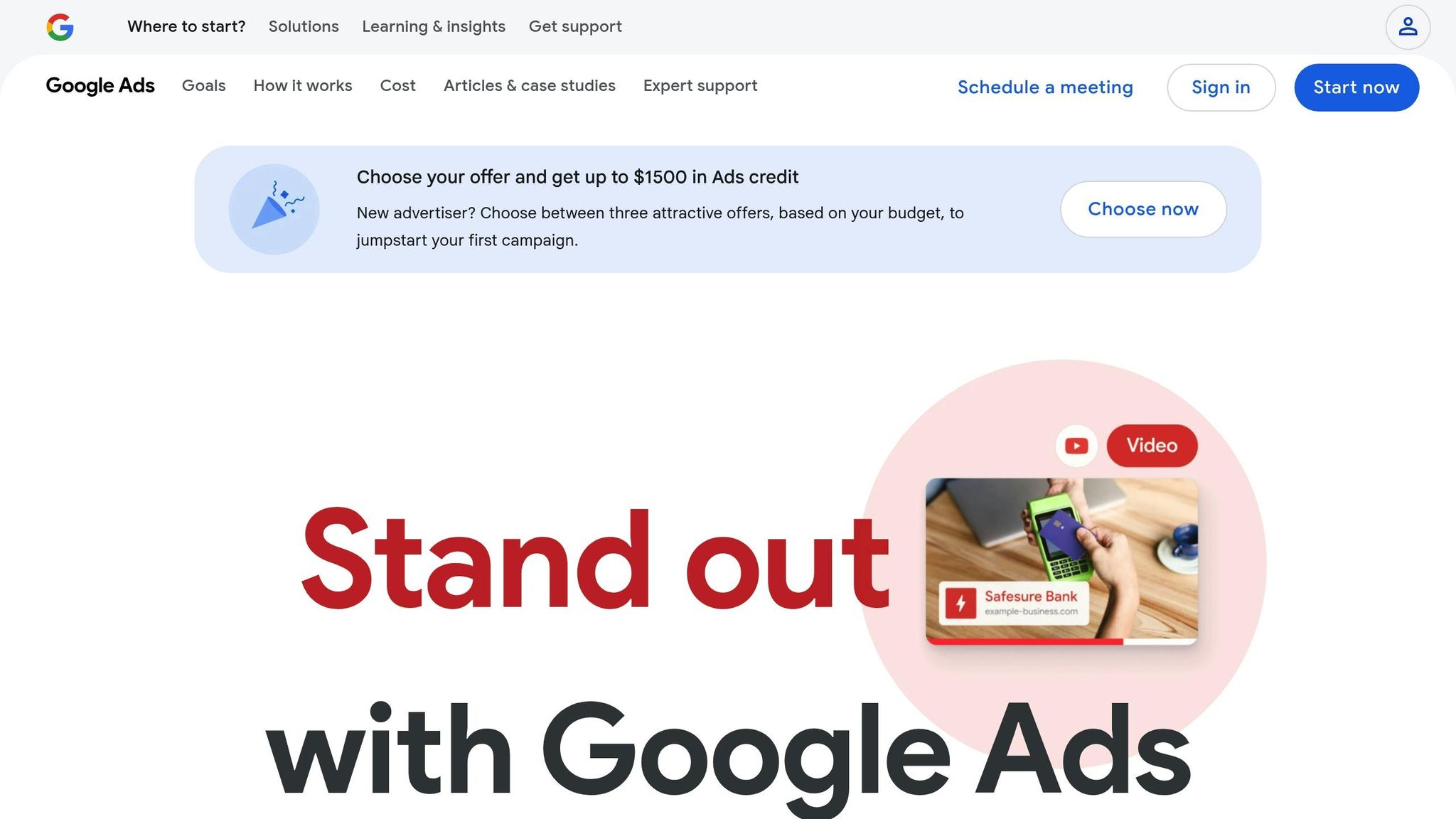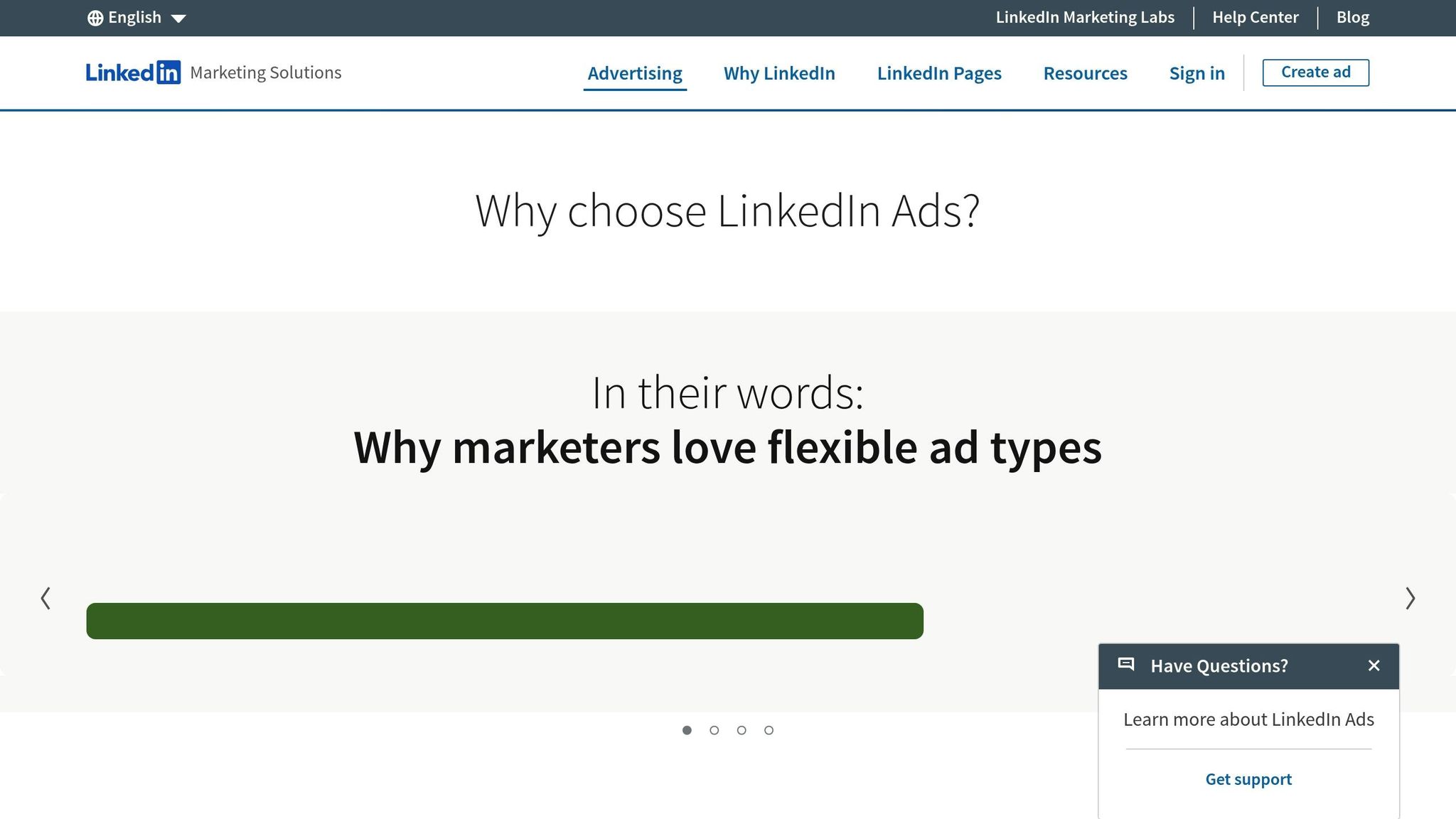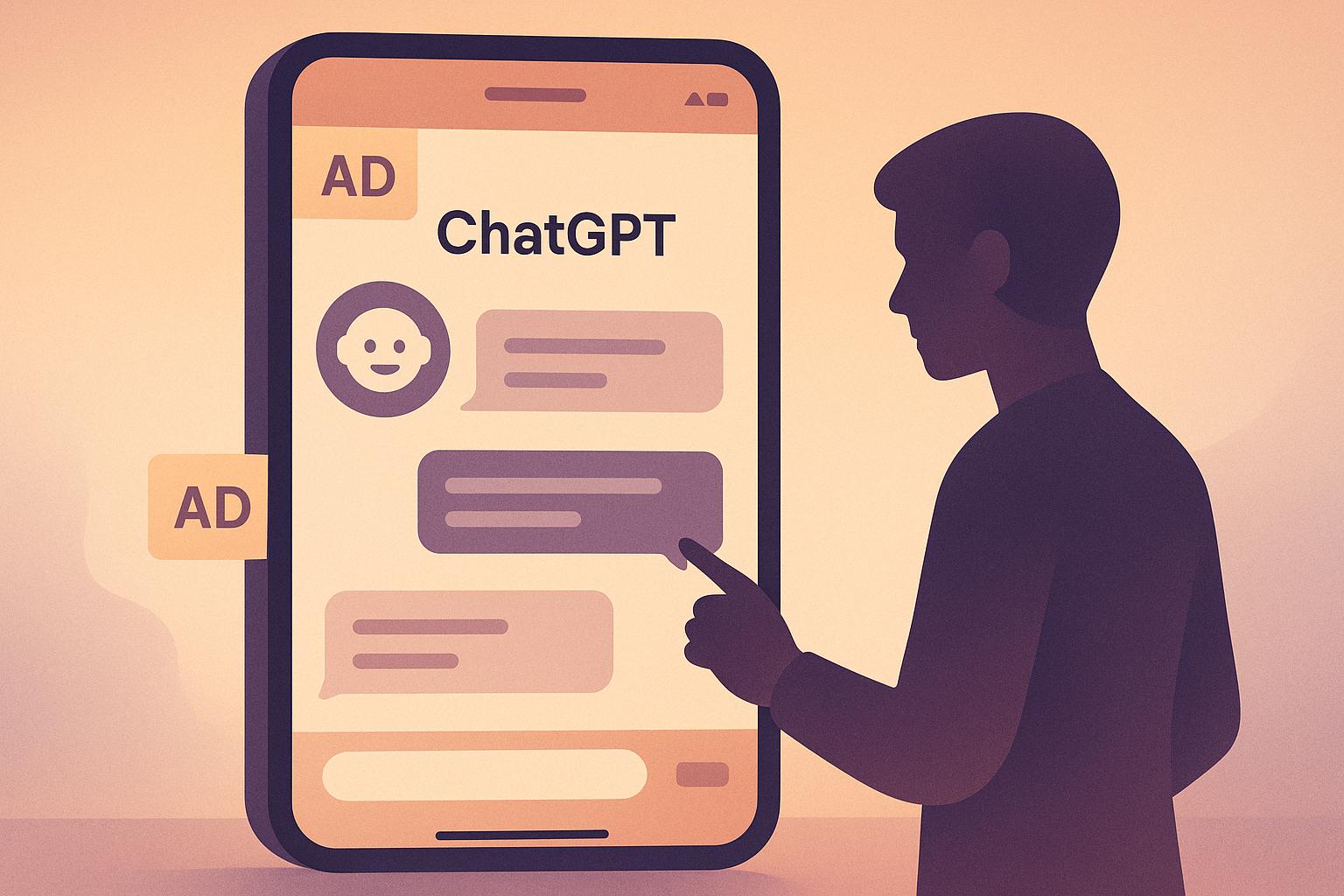


Explore key ROI benchmarks for developer advertising across platforms like daily.dev, Google Ads, and LinkedIn Ads to enhance campaign effectiveness.
Looking to maximize ROI on developer-focused ad campaigns? Here's what you need to know:
- daily.dev Ads: Best for targeting a niche developer audience with native ads. Requires a $5,000 minimum spend but offers precise targeting (e.g., by programming language or seniority).
- Google Ads: Ideal for large-scale campaigns with broad reach. High-intent targeting through keywords and AI-driven tools like Performance Max. Average ROAS is 2:1, with $3.80 CPC for tech campaigns.
- LinkedIn Ads: Perfect for B2B campaigns targeting developers in specific roles or industries. Offers unmatched professional targeting but comes with higher costs and longer sales cycles.
Quick Comparison
| Platform | Audience Focus | Key Strengths | Avg. CPC | Avg. ROAS | Best For |
|---|---|---|---|---|---|
| daily.dev Ads | Developers (1M users) | Native ads, precise targeting | N/A | N/A | Developer tools, niche audiences |
| Google Ads | Broad/global | High-intent targeting, scale | $3.80 | 2:1 | Lead generation, quick results |
| LinkedIn Ads | Professionals/B2B | Precise B2B targeting | $1.68–$4.87 | 113% | Enterprise, long-term campaigns |
Each platform has unique strengths. For niche developer audiences, daily.dev Ads excels. For broad reach, Google Ads is unmatched. For B2B and enterprise campaigns, LinkedIn Ads delivers high-value conversions. Combining platforms often yields the best results.
Ads & Sponsorships for Developer Marketers | Key Takeaways & Final Thoughts
1. daily.dev Ads

daily.dev Ads operates within a vibrant developer ecosystem, connecting advertisers with over 1 million active developers. With more than 1 billion developer interactions recorded, the platform offers a robust base for running targeted ad campaigns aimed specifically at this niche audience.
Targeting Capabilities
daily.dev Ads allows advertisers to fine-tune their campaigns with precise targeting options, including seniority, programming language, tool usage, and geographic location. For example, campaigns can be tailored to reach junior developers, mid-level engineers, or senior architects, depending on the advertiser's goals.
Programming language targeting ensures ads are shown to developers working with specific technologies, making it easier to connect with those most likely to benefit from the advertised products or services. Additionally, advertisers can refine their campaigns based on the tools developers use or focus on specific locations - ranging from cities to entire countries. However, all campaigns require a minimum spend of $5,000, aligning with the platform's focus on enterprise-level advertising.
Ad Formats and Visibility
daily.dev Ads prioritizes native ad placements that fit seamlessly into the developer experience. Ads are prominently displayed in the top feed, ensuring high visibility during users' discovery sessions. The platform offers three key ad formats:
- In-Feed Native Ads: These blend naturally with the content developers are exploring.
- Post Page Ads: Displayed alongside articles, these ads keep the focus on relevant content.
- Personalized Digest Ads (coming soon): Tailored to individual developer preferences for even more precise targeting.
These ads are shown when developers are most engaged - typically during work hours on desktop devices. With 40% of users classified as power users, advertisers gain access to a highly active and attentive audience.
"daily.dev is different from anything you've tried in the past as no other developer platform offers the same level of visibility, intent, and trust."
– daily.dev
ROI/ROAS Performance
While specific ROI benchmarks aren't disclosed, the platform's design suggests strong potential for high returns. Its native ad formats are built to deliver better engagement compared to traditional display ads, leveraging intent-driven targeting to boost conversion rates. Backed by over 1 billion platform interactions, daily.dev Ads is well-positioned to support campaigns focused on tool awareness, event registrations, and resource promotion.
Additionally, advertisers benefit from expert creative guidance to optimize their campaigns. The $5,000 minimum spend reflects the platform's focus on enterprise-level campaigns, with actual ROI depending on how well targeting and execution align with campaign goals.
2. Google Ads

Google Ads stands out by harnessing its massive global reach to attract high-intent traffic. With over 5.6 billion searches daily, it gives advertisers access to users actively seeking solutions - perfect for engaging audiences at key decision-making moments. This extensive reach is paired with advanced targeting tools that make it a go-to platform for precision advertising.
Targeting Capabilities
Google Ads offers a range of targeting features, including keyword targeting, in-market audiences, and affinity audiences, allowing advertisers to connect with users at different points in their journey. For example, you can target developers searching for terms like "API documentation tools" or "cloud deployment platforms".
The combined segments feature takes targeting a step further by layering multiple criteria. This means you can zero in on specific groups, like senior developers in particular regions who specialize in certain programming languages. Additionally, optimized targeting uses machine learning to discover new audience segments likely to convert, expanding your reach beyond the initial parameters.
Ad Formats and Visibility
Google Ads supports a variety of ad formats - text, image, and video - across platforms like Search, YouTube, Display, Discover, Gmail, and Maps. One standout feature is Performance Max campaigns, which use AI to optimize ad performance across all Google channels.
These campaigns automatically allocate budgets to the best-performing channels, ensuring your content gets maximum exposure. As Google Ads explains:
"Performance Max helps you drive results based on your conversion goals, helping deliver more conversions and value by optimising ad performance in real-time and across channels using Smart Bidding." - Google Ads
The Google Display Network alone reaches over 90% of internet users, making it a powerful tool for boosting brand awareness. This variety of formats ensures advertisers can achieve strong visibility and effective results.
ROI/ROAS Performance
When it comes to performance, Google Ads delivers solid metrics, especially for technology campaigns. Across industries, the platform boasts an average conversion rate of 6.96%, while technology campaigns see a 2.92% conversion rate and an average cost-per-click (CPC) of $3.80.
Recent data highlights even more impressive results: a 32.68% increase in conversion rates, a 12.06% improvement in ROAS, and a 7.84% reduction in cost-per-acquisition. However, CPCs have climbed by 10% for 86% of industries.
Several companies have achieved standout results with Performance Max campaigns. For instance, Bewakoof, in collaboration with Adyogi, saw a 5× increase in both conversions and paid traffic, alongside a 3.6× ROAS. Another example is ManyPets, which reported a 27% rise in sales with a 2× return on ad spend.
Overall, Google Ads is estimated to deliver an 800% return on investment, with general campaigns averaging a 2:1 ROAS. For campaigns on the Google Search Network, the returns can climb to $8 for every $1 spent, making it an excellent option for targeting high-intent users.
| Industry Benchmark | Avg. CPC | Avg. Conversion Rate |
|---|---|---|
| Technology | $3.80 | 2.92% |
| B2B | $3.33 | 3.04% |
| Education | $2.40 | 3.39% |
Google Ads excels at capturing users during pivotal moments - when they’re actively searching for solutions - making it a powerful tool for bottom-of-the-funnel campaigns aimed at driving conversions.
3. LinkedIn Ads

LinkedIn Ads takes a focused approach to reaching professional developers, leveraging its vast network of over 1 billion professionals and 67 million companies to deliver highly targeted B2B campaigns. Unlike platforms that rely heavily on search intent or broad demographic data, LinkedIn excels at pinpointing developers based on their professional roles and career contexts. This precision enables advertisers to craft campaigns tailored specifically to their audience.
Targeting Capabilities
One of LinkedIn's standout features is its advanced targeting options. Advertisers can combine multiple criteria - such as job titles, company size, industry, skills, and even specific technologies - to zero in on the right audience. For instance, you could target senior Python developers at mid-sized fintech companies or DevOps engineers with cloud certification experience.
The platform also features a tool called Matched Audiences, which allows marketers to connect with their existing email subscribers on LinkedIn. This makes it easier to run retargeting campaigns that integrate email marketing with LinkedIn's professional network.
Ad Formats and Visibility
LinkedIn offers a diverse range of ad formats designed to engage professionals effectively. Sponsored content - such as single image ads, video ads, carousel ads, and document ads - appears directly in users' feeds. Sponsored messaging enables direct outreach with paid messages, while text ads display on desktop sidebars. Dynamic ads, on the other hand, offer a personalized touch by tailoring content to individual users.
The Campaign Manager provides tools for creating and measuring campaigns. Combining multiple ad formats often leads to better performance; for example, using sponsored messaging alongside sponsored content can boost click-through rates by over 70%.
Recent data from Huble's 2024 analysis reveals some interesting trends in ad format performance. Carousel ads consistently achieved better click-through rates (CTR) than single image ads, though cost-per-click (CPC) varied significantly by region. Video ads saw a roughly 5% increase in view rates compared to 2023, though their conversion rates lagged behind other formats.
| Region | CTR | CPC | Conversion Rate | CPA |
|---|---|---|---|---|
| Americas | 0.53% | $1.68 | 32.89% | $5.99 |
| APAC | 0.56% | $1.90 | 19.77% | $17.40 |
| EMEA | 0.29% | $4.87 | 12.20% | $55.70 |
These insights highlight LinkedIn's ability to deliver strong performance across various ad formats, making it a reliable choice for reaching professional audiences.
ROI/ROAS Performance
LinkedIn Ads stands out for its ability to deliver strong returns on ad spend (ROAS) for developer-focused campaigns. The platform achieves a 113% ROAS, outperforming Google Search (78%) and Meta Ads (29%). While LinkedIn may require a higher initial investment, it offers a 25% lower cost per company influenced compared to Google Search - and a staggering 70% lower than Meta.
Conversion rates on LinkedIn are three times higher than on other major platforms, largely due to its professional context and the high intent of its users. Additionally, LinkedIn boasts a 13.5% lower cost-per-acquisition (CPA), making it a cost-effective option for B2B lead generation.
B2B SaaS companies are increasingly prioritizing LinkedIn in their ad budgets, with over 30% of their annual advertising spend going to the platform in Q4 2024. Performance metrics varied by quarter: Q3 achieved a spend-to-pipeline ROI of 6.01×, while Q4 delivered a spend-to-revenue ROI of 2.46×, thanks to impression-level tracking. Though LinkedIn's longer sales cycle - averaging 320 days from first impression to revenue - requires patience, it often results in higher-value conversions that justify the investment.
sbb-itb-e54ba74
Platform Strengths and Weaknesses
After reviewing performance metrics, here’s a breakdown of the strengths and challenges of each platform to help you make informed decisions about reaching developer audiences and allocating budgets for maximum return.
daily.dev Ads stands out for its native integration and a highly focused developer audience of over 1 million active users. It’s a great choice for reaching technical audiences within a dedicated ecosystem. However, its narrower scope means you may need to pair it with other channels to broaden your reach.
Google Ads offers unmatched scalability and quick results, making it a go-to for generating leads and tapping into a broad audience. Its flexibility in budget management and detailed performance tracking are major advantages. That said, businesses should watch out for higher cost-per-click rates, especially in competitive industries, and allocate resources for ongoing optimization.
LinkedIn Ads excels in targeting professionals based on their roles, industries, and company profiles, making it a strong contender for B2B and enterprise campaigns. The trade-off? Higher initial costs and longer sales cycles, which may not suit every budget or timeline.
"The most important metric for measuring success is the one the business is paying for. If they say they want leads, then CPL is king. If they say they need web traffic, CTR or CPC may be more important".
Interestingly, research by Les Binet and Peter Field highlights that brand-focused campaigns can deliver up to four times the bottom-line impact compared to campaigns that overlook brand metrics.
Here’s a quick summary of each platform’s strengths and weaknesses:
| Platform | Key Strengths | Primary Weaknesses | Best For |
|---|---|---|---|
| daily.dev Ads | Native integration, precise developer targeting | Limited reach; may need multi-channel | Developer tool launches, technical content promotion |
| Google Ads | Immediate results, massive scale, flexible budgets | High cost-per-click; requires regular optimization | Lead generation, broad market reach |
| LinkedIn Ads | Professional targeting, effective for B2B | Higher costs; longer sales cycles | Enterprise sales, B2B marketing |
For smaller budgets, daily.dev Ads provides focused engagement with developers. Google Ads is perfect for scaling campaigns quickly and flexibly, while LinkedIn Ads, though pricier, delivers strong results for B2B-focused efforts.
Ultimately, the key to maximizing ROI lies in constant monitoring and fine-tuning. Often, combining platforms delivers the best results, allowing businesses to connect with developers at every stage of their journey - from initial awareness to final conversion. By aligning your campaign goals with the platform that fits your audience and budget, you’ll set the stage for success.
Conclusion
Maximizing ROI in developer advertising requires a strategic approach grounded in data. The analysis highlights the strengths of key platforms like daily.dev Ads, Google Ads, and LinkedIn Ads, each offering distinct advantages for reaching developer audiences.
daily.dev Ads stands out for its ability to connect with a highly engaged developer community. With over 1 million active developers, this platform is ideal for promoting developer tools and technical content. Its native integration ensures your message reaches the right audience in a relevant context.
Google Ads offers unmatched scalability and quick results, delivering a return on ad spend (ROAS) of 2:1. While the ROI might seem modest, Google's vast reach and advanced targeting capabilities make it essential for lead generation and market expansion. However, managing higher cost-per-click rates requires ongoing optimization to maintain efficiency.
LinkedIn Ads excels in precision targeting, particularly for enterprise-focused developer tools and services. Although its premium pricing and longer sales cycles might seem challenging, the platform's professional audience targeting can deliver strong results for the right campaigns.
The most effective strategies often combine multiple platforms to ensure broad coverage while managing costs effectively at different stages of the developer journey. For example, segmented campaigns and personalized approaches can significantly boost revenue - by as much as 760%.
As the developer advertising landscape evolves, staying proactive is key. Regularly analyze performance metrics, experiment with A/B testing, and adjust your platform mix to align with emerging trends and new ad formats. By leveraging the unique strengths of each platform and refining your approach, you can achieve sustainable success in developer advertising.
FAQs
What makes daily.dev Ads uniquely effective for reaching developer audiences?
Why Choose daily.dev Ads?
daily.dev Ads offers a unique opportunity to connect with developers through precise targeting. With the ability to tailor your ads based on factors like interests, seniority level, programming languages, and tools, your message reaches the right audience at the right time. This kind of specificity ensures your ads resonate, driving better engagement and delivering a stronger return on investment compared to broader advertising platforms.
What sets daily.dev apart is how naturally ads are integrated into the platform. Using native placements such as in-feed and post page ads, the ads blend seamlessly into the developer's browsing experience. This approach not only builds trust but also boosts click-through rates by making the content feel relevant and unobtrusive.
With a thriving community of over 1 million developers, daily.dev provides a trusted space to promote tools, events, or resources to a highly tech-savvy audience. If you're looking to connect with developers in a meaningful way, this platform is the perfect match.
What are the best strategies to optimize LinkedIn Ads given its higher costs and longer sales cycles?
To get the most out of LinkedIn Ads, even with its higher costs and extended sales cycles, it's essential to focus on a few smart strategies. First, set specific campaign goals that align with your business objectives. This not only helps you track success but ensures your ads are working toward clear outcomes.
Take advantage of LinkedIn's advanced targeting features to zero in on the right decision-makers - this is especially effective for B2B campaigns. The platform's ability to narrow down your audience by job title, industry, or company size can make a big difference.
Make sure your ad creatives are engaging and highly relevant to grab attention and boost click-through rates. Keep an eye on your campaign performance and use the data to make informed tweaks, like adjusting your audience settings or experimenting with fresh ad designs.
Don't forget to use LinkedIn's tools, like the Insight Tag, to track conversions and retarget users who've already interacted with your ads. By applying these strategies, you can tackle LinkedIn's challenges head-on and make the most of your ad budget.
How can I effectively combine daily.dev Ads, Google Ads, and LinkedIn Ads to maximize ROI in developer-focused campaigns?
To get the most out of your developer-focused campaigns on platforms like daily.dev Ads, Google Ads, and LinkedIn Ads, it’s essential to tap into the specific strengths each one offers. For instance, daily.dev Ads allows you to connect with developers through highly targeted native ads. Google Ads, on the other hand, is perfect for capturing traffic from intent-driven searches, while LinkedIn Ads is a strong choice for reaching tech decision-makers in a B2B setting.
Start by setting clear goals - whether it’s boosting developer engagement or driving sign-ups. Use audience insights to craft messaging and targeting strategies that resonate on each platform. Incorporate A/B testing to fine-tune your ad creatives and strategies based on what performs best. Additionally, make use of the automation tools these platforms provide to simplify campaign management, enhance targeting accuracy, and ultimately reduce costs while improving your ROI.






